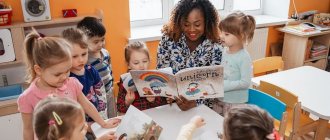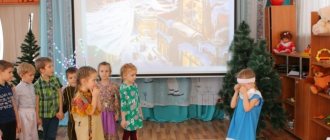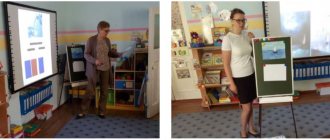Plan for the Russian Language Week in the preparatory group
Tynkova Olga
Plan for Russian Language Week in the preparatory group
Compiled and completed:
teacher at GBOU school No. 51
Preparatory group
Russian Language Week
Monday.
1. “My native country is wide.” (conversation)
Goal: to expand children’s ideas about their homeland, to give an idea of the diversity of peoples living in Russia and the many languages and nationalities .
2. Reading p. n. fairy tales "Kozma Skorobogaty"
Drawing illustrations for a fairy tale.
Goal: conversation about Russian folk tales , consolidate the concept of a fairy tale, teach to notice figurative words and expressions in fairy tales.
1. Theater “The Tale of a Stupid Mouse”
Goal: to deepen children’s knowledge about the work of S. Ya. Marshak, to please, entertain children and create a positive mood.
2. Dramatization game “Here’s the absent-minded one from Baseyannaya Street.”
Goal: continue to teach children to participate in dramatization games.
1. Round dance game “Little Little Lambs”
Goal: to learn the round dance game with the children, continue to teach how to coordinate the word with the movement.
2. Game “Guess it”
Goal: to teach children to describe an object without looking at it, to find significant features in it and to recognize the object by description.
1. Quiz “Visiting a fairy tale”
Goal: to consolidate children's knowledge about Russian folk tales in a playful way.
2. Drawing on the theme “My favorite fairy tale”
3. Folk game “Boyars”
Goal: to teach children to coordinate the verb with the action.
1. Table theater “Moroz Ivanovich”
Goal: to continue to teach how to emotionally perceive works of oral folk art.
2. Evening of riddles “Riddles of the old Godovik”
Goal: To introduce the polysemantic word needle. Correctly pronounce the sounds s and z in words and phrases. Pronounce sentences at different tempos and with different voice strengths.
Traditions of the Russian people as a means of learning the Russian language with preschool children Municipal budgetary preschool educational institution Kindergarten “Damyrak” Report on the topic: Traditions of the Russian people as a means.
Improving forms of work with teachers in preschool educational institutions. Plan for the Week of Psychology On the path to mutual understanding Improving forms of work with teachers Kindergarten is one of the first social institutions with which it is the first time.
Plan for conducting the methodological week “Formation of the foundations of environmental culture in preschool educational institutions” 2021 has been declared the year of ecology. One of the annual tasks of our kindergarten is environmental education, which also includes...
Plan for the Health Week in the senior group Plan for the health week in the senior group Monday Morning exercises Conversation “What helps you be healthy” ECD for development.
Plan for the week “Winter Games and Fun” 2014 Group No. 8 Goals: to provide children with a good active holiday during a winter walk. Objectives: expand the list of sports games etc.
Plan for the Week of Winter Games and Fun Monday: January 22 Sports Games Day I – half day: Conversation based on pictures “How children play in winter” Conversation about sports in winter.
Plan for the methodological week “New Year is knocking on the door!” Plan for the methodological week “New Year is knocking on the door!” Goal: to promote the development of the creative potential of teachers, to expand.
Source
Teaching Russian as a second language in kindergarten
Lyudmila Solomeina
Teaching Russian as a second language in kindergarten
Self-education on the topic: Teaching Russian as a second language in kindergarten.
I chose the topic of self-education not by chance, since this is a very important problem for parents and their children who speak Russian as a second language.
In recent years, children of different nationalities who do not speak Russian as a native language are increasingly coming to kindergartens in Moscow.
At home they speak with their parents and other relatives in their native language (for example, Azerbaijani, Armenian, Ossetian, and in kindergarten they begin to master Russian.
The article I came across reveals the system of work of a preschool educational institution for the formation of bilingualism in preschool children. It describes how teaching Russian as a second language to children can be organized, based on the interaction of all kindergarten teachers.
As the results of domestic and foreign studies show, the most promising in relation to such families is an integrative approach, which is implemented in kindergarten. This means that, along with teaching the Russian language, work is carried out aimed at preserving the native language, i.e., at the formation of full-fledged bilingualism in children. Of course, in the conditions of a Moscow kindergarten, in which children of various nationalities are brought up at the same time, it is impossible to organize actual speech work to support each of the children’s native languages, therefore the emphasis is on emphasizing the importance of the child’s command of two languages.
In order for work with bilingual children to be effective, it is necessary to organize joint activities between the kindergarten and parents. In conversations with parents, the kindergarten teacher constantly emphasizes that how developed the child’s native language is will determine what success he will be able to achieve in mastering Russian as a second language. The system of classes for middle-aged children in the group is structured in such a way that the same topic is studied by children at the same time throughout the year. Based on the general context that sets the content of the teacher with all children, the content of the work on teaching children Russian as a second language is determined. Words and adjectives are selected that the teacher includes in his speech addressed to bilingual children. These are phrases that are used during meals, during various activities, when dressing for a walk and during the walk itself, when organizing children’s games or putting them to bed. At the same time, the content of individual lessons with bilingual children is determined, which the teacher conducts in a group in the afternoon. Classes taught by kindergarten teachers help enrich the vocabulary of a bilingual child, assimilate various phrases and speech structures, idiomatic expressions, and make a significant contribution to the work of teaching children Russian as a second language.
For example, when studying the topic “Clothing”, the teacher in the group constantly uses the expression type in appropriate situations.
Put on, (take off, hang, put, put, (red, blue, green - T-shirt, jacket, hat (red, blue, green - scarf, sweater, sock). This is my jacket, These are your sneakers, This is your shoe, Where is yours dress, your scarf. During individual lessons with bilingual children, the teacher in the group conducts didactic games, which also use vocabulary on the topic “Clothing.” The teacher organizes the acting out of dialogues in situations of the “Clothing” store.
Kindness, patience and understanding are the basis of a teacher’s work in a kindergarten group with bilingual children.
One of our main tasks is to help such children establish contact with others so that this does not become an obstacle for the children in their development.
We teach the Russian language in various types of activities, classes, games, everyday life, i.e. when children communicate with each other and with adults, thanks to which they master not only Russian, but also the culture of communication.
Not all children who speak Russian poorly can behave relaxed in public and answer questions publicly. Shyness in such children manifests itself in a lowered head, downcast gaze, a quiet voice, and erratic movement.
We strive to support such children, we invite them to answer the question with an adult, telling them that they will definitely succeed.
Of course, the main thing in working with such children is kindness, patience, understanding and acceptance of the conditions of family national education, if it takes place and does not run counter to generally accepted norms.
We are obliged to help such children cope with their problems. Fear of contacts with other children, isolation, fear of being ridiculed, fear of receiving a negative assessment from an adult - all this interferes with the development of communication and also the development of personality in general.
The teacher should, as often as possible, give positive assessments to bilingual children in the presence of other children, paying attention to even minor successes of the child in various activities.
We constantly celebrate the positive qualities of children and demonstrate our own kind attitude towards children of other nationalities.
Working with parents of bilingual children.
Working with parents is a very important job, since parents often feel that having moved to Moscow, the family should give up using their native language and communicate with children only in Russian, even if the parents themselves do not speak Russian well enough. Kindergarten teachers explain to parents the impossibility of giving up the family’s native language and together with them find optimal options for supporting both the native and Russian languages, i.e., the formation of true bilingualism. It is necessary to convince parents that the more clearly the languages are separated in the child’s environment, the easier it is for him to call everything by its proper name and not confuse languages.
Tips for parents: Parents should be attentive to the speech of their children.
Make sure they pronounce the words clearly enough.
Are they mixing languages?
Do they have time to name all the surrounding objects and actions in this language?
Ask questions about kindergarten more often (how the child spent the day in kindergarten in Russian.)
Offer parents educational games to play at home.
Some parents are afraid that two languages is too much of a burden on the child. Research by scientists shows that this is not the case. Learning languages is in human nature, this activity develops the brain. And then, this can be done fun, in games, with poems, songs, theatrical performances. Childhoods become a whole world richer!
Methods of teaching Russian language:
– natural communication in Russian, when possible, but this is not mindless speaking for the sake of filling pauses, but structured, progressively more complex, easy-to-understand adult speech addressed to a child;
– conducting special classes that can be conducted based on the children’s native language, in different types of activities and at special moments by native speakers of a second language;
– use of sound and intonation aspects of speech. The ability to recognize, identify and realize units of language and speech arises, in which language plays the role of a catalyst for cognitive processes: everything that exists in the surrounding reality should receive a second name;
– use of general methodological principles of working with preschoolers (active communication, play, entertainment, clarity, repetition, systematicity, flexibility);
– use of linguistic material based on the native language and organization in the comparative aspect of languages and cultures, mutual enrichment of cultures.
Using second language techniques in artistic creativity.
Working with bilingual children, I encountered another problem: when a teacher has planned some kind of practical activity, he, first of all, must demonstrate the purpose of this activity: visually - or with the help of translation - verbally. If the task is creative, you first need to discuss the situation itself in which the result of the children’s work will be used, what it should be and why. The teacher explains his work as much as possible, shows and names all the tools necessary for its implementation, draws, perhaps on a large sheet of paper or board, a work plan or one of the options for a craft or drawing. Then the teacher works in front of the children and achieves some kind of intermediate or final result, depending on the complexity of the plan. When the children began to work, the teacher approaches each one in turn, names the details of the image, tools, repeats fragments of the explanation, asks the child what he is doing now and what he will do later, offers options for developing the plan, encourages successful aspects of the work.
There are typical figures of speech: For example, for modeling we need: plasticine, oilcloth, stick; plasticine can be crushed, rolled, squeezed, pressed; You can make lumps, balls, sausages, and cakes from it; characteristics of objects: long, short, round; expressions: with both hands, between the palms, in a circular motion; After the children have done the crafts, you can play (Here’s an apple for you, doll, look how big, beautiful, smooth it is. It’s probably very tasty, sweet. Let’s try it! Yes, very tasty. Do you want another piece? Take a plate and put it on the table You see the doll took the apple in her hands and eats it.
All methods are very good, but the most important thing: Conclusion: children should feel comfortable, know that they are welcome in kindergarten, want to play with them, are accepted and loved very much because they are an individual, since each person comes to this world is unique in its own way and its presence enriches everyone.
Summary of a Russian language lesson in a preparatory school group
Ilmira Galiakberova
Summary of a Russian language lesson in a preparatory school group
TOPIC: “Journey through the topics studied”
.
• Systematize children's knowledge on the topics covered;
• Improving listening and proficiency skills
wear of words with acquired sounds of the Russian language and their combinations
• Development of logical thinking, attention and memory.
• Development of fine motor skills of the hands.
Materials: slide, pictures, audio recording “Knock on the door”
.
Methods of teaching Russian to preschoolers
“Features of teaching Russian to preschoolers in kindergarten”
Target:
determination of the main possible directions in teaching Russian to preschool children.
Tasks
:
To identify the capabilities of preschool children in learning the Russian language.
Form the main goals and objectives of teaching the Russian language to preschool children
Determine the main methods of teaching preschoolers the Russian language.
It is known that the opportunities of an early age in mastering foreign language speech are truly unique. Even K.D. Ushinsky wrote: “A child learns to speak a foreign language in a few months, as he cannot learn to speak in a few years.”
Russian language teaching is carried out in middle, high school and kindergarten groups.
The Russian language in Kazakhstan has a constitutionally enshrined status as a language of interethnic communication and plays an important role in the development of the economy, culture and education. Good knowledge of the Russian language is the basis for successful schooling.
Taking into account the importance of the Russian language, the state compulsory education standard of the Republic of Kazakhstan has introduced compulsory teaching of the Russian language to children who are raised and studied in groups with the Kazakh language of education and training, starting from the age of three.
Preschool age is an important sensitive period for the development and cognition of language, a time of active vocabulary development. Teaching the Russian language to Kazakh children in the preschool period ensures the strength of knowledge acquisition during schooling.
For preschoolers, the main activity is play. The methodology for teaching the Russian language involves conducting games such as role-playing games, moving games, round dances, finger dances, board games, theatrical games, as well as interesting speech physical education minutes.
So, it is important to take into account the individual characteristics of the child. However, we must not forget such basic principles as respect for the child’s personality. If a child, when communicating with a teacher, feels like an individual, that he is respected, that he is taken into account, then, of course, he will try to prove himself, will be active and sociable.
Considering that at this time children are oversaturated with information, it is necessary that the learning process be interesting, entertaining, and developmental for them
It should be taken into account that in order to realize the great positive opportunities of preschoolers in teaching the Russian language, work must be built on the basis of a clearly thought-out methodological system that takes into account the age characteristics of children 4-6 years old. During the learning process, children must learn to perceive and understand Russian speech by ear and speak Russian within the range of topics available to them, learned words, grammatical forms, syntactic structures and simple examples of coherent speech.
The main form of teaching the Russian language is the lesson. The main goal of the classes is to stimulate the speech activity of children, stimulate spoken language, and achieve the correctness of Russian speech. When planning work on teaching children the Russian language, the teacher must take into account the specifics of Russian-Kazakh bilingualism, the speech situation in the group, in families, and the level of understanding of the Russian language by children. Each lesson provides a comprehensive solution to speech problems, where, regardless of the topic and specific tasks, work is simultaneously carried out on phonetic, lexical, grammatical aspects of the language, and coherent speech skills are developed.
The structure of the lesson could be as follows:
Organizing time;
vocabulary - consolidation of words learned in the previous lesson, introduction of new vocabulary;
phonetics - articulation of sounds of the Russian language, pronunciation of sounds in Russian words, games and exercises to consolidate sounds;
- coherent speech - examination of plot pictures, conversation and composing stories according to the model given by the teacher; writing descriptive stories; stories about personal life events,
retelling of works of art;
— grammar — games and exercises for mastering grammatical forms (gender, number, case) of the Russian language;
-games and exercises to reinforce the topic; memorizing poems and rhymes; telling tales, etc.
All basic teaching methods are reinforced in the classroom with appropriate visual examples - showing objects, pictures, toys, dummies, etc. In order for a Russian word to enter the child’s memory without translation into the native language, it is necessary to connect not only vision and hearing (names of objects, but also touch (touch an object, smell (smell, taste). Visual learning helps children consciously and firmly master the Russian language.
Demonstration of objects in nature or their images in a painting makes the lesson lively and interesting. For example, when studying the topic “Clothing”, the teacher in the group, in appropriate situations, constantly uses expressions like:
Put on/take off/hang/put on/put down...red/blue/green t-shirt/jacket/hat...red/blue/green scarf/sweater/sock...red/blue/green shorts/socks/boots. Is this your jacket? Are these your sneakers? Is this your shoe? Where is your dress/your scarf? What color are your pajamas – blue or red? Etc.
During individual lessons with bilingual children, the teacher in the group conducts didactic games, which also use vocabulary on the topic “Clothing”. These can be games like “Memory”, “Match a Pair”, “Loto” or “Who can dress the fastest”, in which, in accordance with the number of points rolled on the dice, children put different clothes on paper figures of two dolls.
The focus of the teacher’s attention should always be on developing and improving children’s skills in correct Russian pronunciation and eliminating existing deficiencies. Each lesson should include a 2-3 minute phonetic exercise aimed at developing children’s phonemic hearing and developing pronunciation skills. Such an exercise can be carried out in the form of games “Echo”, “Clock”, “Chain”, etc., recommended by the program. To reinforce new words, a variety of game exercises and situations are widely used in each lesson. (For example, the game “Let’s arrange furniture for a doll” (fixing the names of pieces of furniture). On the teacher’s table there is a doll, children’s furniture, a car. Educator: “Children, our doll Masha has moved to a new apartment. She bought herself new furniture. Furniture brought by car. Let's help Masha unload the furniture" (calls the children one by one and invites them to find the right thing in the car). An effective method of enriching children's vocabulary is games - dramatization based on the plots of poems, Russian folk tales, works of Russian writers, which help to consolidate the new vocabulary, developing the ability to build dialogue and coherent texts. Even silent, inactive children want to participate in such games. Children also easily learn vocabulary and grammar by dramatizing these fairy tales in Russian.
In classes, teaching the lexical side of speech is based mainly on visual aids: toys, pictures, images of actions, gestures, facial expressions. The vocabulary includes vocabulary on topics that are well known to children in their everyday lives (“Games and toys”, “Family”, “Home”, “Animals”, etc.) The selected vocabulary is specific. Basically, children learn the names of objects in the material world, the names of typical actions and signs of objects that are already familiar to them in their native language. Vocabulary is introduced gradually in large thematic groups and practiced in various games. Words are not introduced in isolation, but in combination with other words or in a meaningful situation in the game.
Teaching grammar presents certain difficulties. Mastering grammatical skills is built on the basis of speech patterns using the principle of analogy with the native language. The child must realize that any language is built according to its own laws, which must be observed in order for the statement to be understandable. To do this, you can use specially designed grammar games, fairy tales, stories and poems. It is important to adhere to the stages of speech skills and abilities. The child perceives a new linguistic phenomenon, reproduces it under the guidance of the teacher, and includes this linguistic phenomenon in his speech during games, tasks, and speech exercises. We also work on teaching the Russian language in our free time.
The family plays an important role in a child’s acquisition of Russian speech. I conduct consultations, conversations, give recommendations and advice on language learning. In the future, I would like to involve parents in the preparation of folklore holidays in Russian, such as “Broad Maslenitsa”, “Russian gatherings”, “Alyonushka’s fairy tales”. These events make it possible to achieve high results in the development of children’s Russian speech, provide an opportunity to immerse them in the culture of the Russian people, and contribute to the establishment of friendly and productive contacts with parents.
The language environment must be developmental in nature. The concept of a language development environment includes both the language environment itself and the child’s subject-development environment in the classroom. In the language learning classroom, the subject-development environment is created in accordance with the age characteristics, interests of children, taking into account program requirements. Speech games are presented in the form of separate cards. Using these unique cheat sheets it is always convenient to remember this or that game. All material has been systematized and a card file has been compiled.
According to all kindergarten teachers, in this case we can talk about the child’s actual bilingualism, which was formed through the joint efforts of parents and teachers, each of whom tried to do everything possible for this. The coordination of the actions of all kindergarten specialists also played a significant role in this.
Bibliography:
1.B.S.Omar.A.T.Sadyk, N.V.Domanova Methodological manual for teachers of preschool organizations with Kazakh language of education and training for the educational and methodological complex “Speaking Russian”
2.Protasova E.Yu., Rodina N.M. Methods of speech development for bilingual preschoolers: a textbook for university students studying in the specialty “Preschool Pedagogy and Psychology”,
3. Developmental activities for children 5-6 years old. Ed. L.A.Paramonova. – M.: Olma Media Group, 2008.
4. Developmental activities for children 4-5 years old. Ed. L.A.Paramonova. – M. – Olma Media Group, 2010.
5. Shtanko I.V. Project activities with children of senior preschool age. Journal “Management of a preschool educational institution
Progress of the lesson.
- Guys, guests came to our Russian language . Let's turn to them and say hello.
- Guys, turn to each other, look into each other’s eyes, smile at each other, wish each other a good working mood in class. Now look at me. I also wish you to work together and discover something new.
- Guys, what month is it now? - It's May now.
– May – what month? Spring or summer?
– This is the last month of spring.
- Guys, what holiday are we preparing for? – This is a holiday – “You-
- Yes, guys, soon you will say goodbye to kindergarten, and then where?
will you go? - We'll go to school .
- Guys, why do you need to go to school ? - In order to study.
He teaches the kids order,
He checks the children's notebooks.
Teach children to write and read,
And adding numbers and subtracting.
- Who is this? - This is a teacher.
- That's right, guys. at school . And in the children's
who was with you in the garden? - These are our teachers.
- Who else? – Our beloved nanny, assistant teacher.
3. -Oh, who is this! Look at the screen: who are these guys?
- Dunno sent us a letter by e-mail, let's read it.
“Hello, dear guys! Please help me find among
Before we begin the task, let’s do some eye exercises:
4. Gymnastics for the eyes “A beetle flew into the clearing”
.
A beetle flew into the clearing,
He buzzed and sang - w-w-w.
So he flew to the right (the children look to the right,
So he flew to the left (children look to the left)
.
Beetle, here is the right palm (stretch the right palm forward,
Beetle, here is the left palm (stretch the left palm forward)
.
The beetle flew up
And he sat down on a branch.
We stood up on our toes,
But we didn’t get the beetle (stand on tiptoes, reach up)
.
Let's clap together: clap-clap-clap
So that he could fly away - w-w-w (clap their hands)
.
- Now turn your attention to the screen!
Crocodile is an amphibian animal. And the rest live on land.
An airplane is an air transport. A-ground transport.
5. Dunno says that she doesn’t know where her right hand is and where her left hand is.
Game “This is the right handle”
.
I will have pens
Look - my palm
Like a cheerful accordion:
I spread my fingers
And then I move it again.
(Children repeat the movements together with the teacher, repeat the words.)
Lesson on speech development in the preparatory group: “Native language experts”
Age: preparatory group 6-7 years.
Goal: Development of speech and communication abilities in children through play with elements of competition.
1. Support the manifestation of the child’s subjective position in verbal communication with adults and peers.
2. Continue to develop children’s monologue speech, speech creativity, and interest in writing.
3. Develop dialogical speech skills, participate in a collective conversation, and answer questions posed.
4. Practice the ability to compose sentences from deformed text, coordinating words (gender, number, case) in the sentence.
5. Strengthen the ability to identify the first and last sound in words, reading short words.
7. Continue to strengthen the ability to form phrases from the proposed words.
8. Maintain interest in this type of literary genre, such as a mystery.
9. Continue to develop memory, logical thinking, fantasy, imagination.
10. Develop the ability to work in small groups, negotiate, rejoice not only for your successes, but also for the successes of your comrades, and evaluate yourself.
Materials and equipment:
Playing field, chips, cubes, task cards.
Progress of educational activities.
Hello guys, I came to visit you, my name is Buratino. What is your name? (Children pass the ball around and say their names.)
Guys, do you like to play? I have a very interesting game for you, it’s called “Native Language Experts.”
Do you want to play it?
Who do you think the experts are? (Children's answers.)
What is a native language? (Children's answers.)
Before you start the game, select each picture of an owl or a book. These are symbols of wisdom and knowledge.
Well, you are divided into teams. A wise owl means you are wise men, and a book, a source of knowledge, means you are experts. Do you agree or want to choose other team names?
(Children stand in a semicircle in front of a table with a playing field.)





